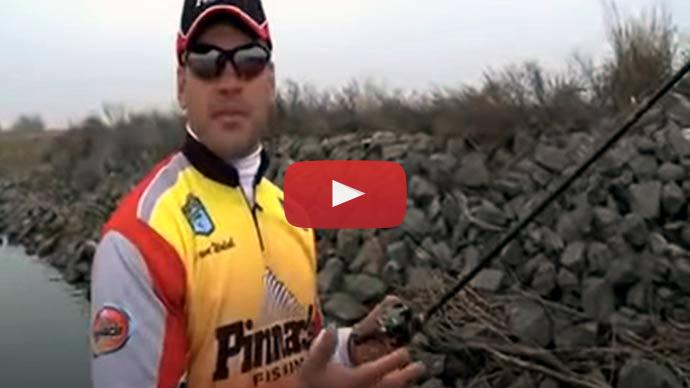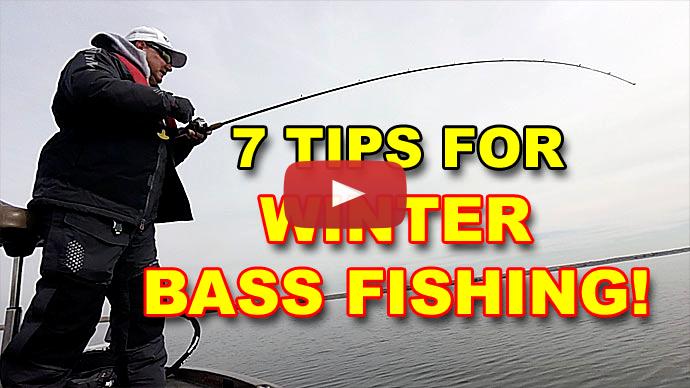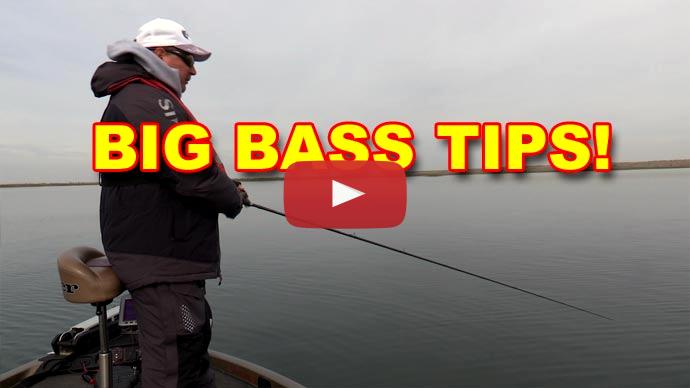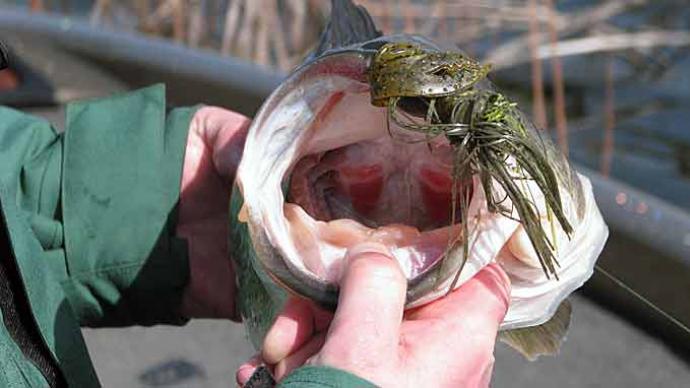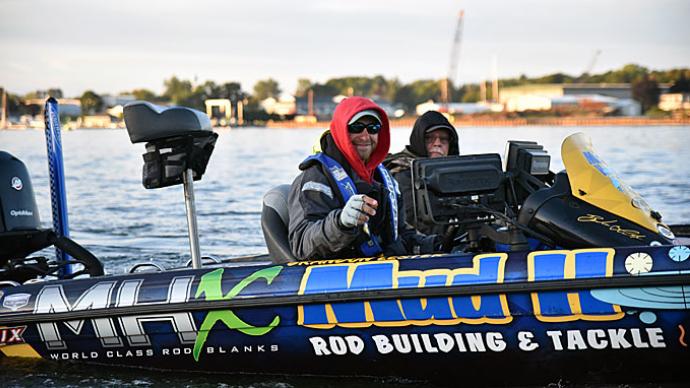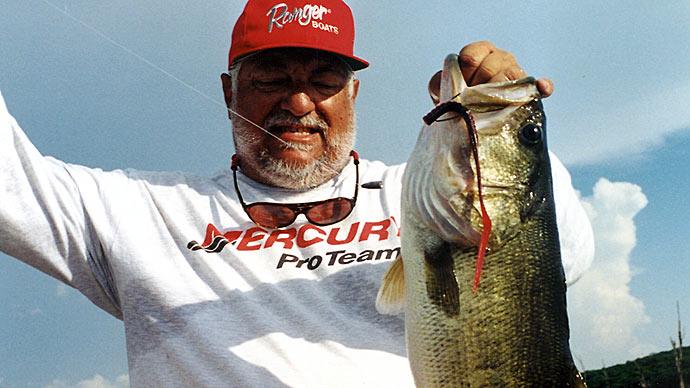Keri: Oh, you're pulling like you're mean.
Glenn: There you go. That's a bit better.
Keri: Pulling like you're mean.
Glenn: That's a good fish there. There you go. That's a largemouth.
Keri: Boy, oh, boy, you are not happy with me.
Glenn: There we go. That does the trick.
Keri: That does the trick. Drop shot fish. There we go. There we go. Much better fish. Much better.
Glenn: That works.
Keri: That's what we've been waiting all day for.
Glenn: That's a good one.
Keri: Thank you, dude. Put a little belly on him.
Glenn: Yeah, that works.
Keri: Little fish. Drop shotting. Here you go, baby. Thank you for the play. That was fun. Slowly just saunters off.
Glenn: Hey, folks, Glenn May here with BassResource.com. We're getting into the wintertime, and I know it can be tough. Winter can be the toughest time a year to catch bass. You don't get a whole lot of bites. It's cold. It can be miserable out, physically. You know, it's tough to be outside and the bites are few and in between.
So it takes a lot of concentration. What's worse yet, is sometimes trying to figure out what baits to use to figure out what the bass are going to hit. So today I wanna help you out. I'm gonna give you my top three baits that I use during the wintertime that catch bass the entire season. And hopefully, it'll help you.
So starting off with the Finesse Worm, specifically a 4-inch Finesse Worm. Specifically even more is a 4-inch hand-poured Finesse Worm. Now there's several reasons for that.
First of all, a Finesse Worm doesn't have a whole lot of appendages so it's not super action, but it gives off a real natural action. And that's where the hand pour comes into play. When the water temperatures get down below 50 degrees, plastic begins to lose its flexibility.
And a normal mass production plastic kind of becomes like a chunk of plastic. It really doesn't move a whole lot, relative to when you have it out of the water. This is why I like hand pours. Hand pours out of the water are super flexible and bendy, and they have all kinds of action. But once you get it in the cold water it kinda stiffens up a little bit and it doesn't move as much but it still looks natural, nice and slow-moving and has all kinds of flexibility to it.
So I really like a 4-inch hand-poured plastic worm, you know, the Don Iovinos, there's Western Plastics, there's few others on the West Coast that make 'em. The one exception I would say would be the Roboworms. Roboworms, it is mass-produced but that plastic is such that it really does feel like a hand pour and acts like a hand pour.
But other than that, I go straight hand pours, 4-inch worms, and I put 'em behind a split shot rig, I put 'em behind a drop shot rig, and just work it real slow over deep cover, deep structure. Anything deeper than 15 feet deep. What I'll do is, the split shot rig, I use that, I move it a little bit faster.
I use that to cover water, and I'm going over deep points, sharp points. I like deep edges or sharp, deep banks, like, 45-degree banks or sharper. I'll look for humps, any kind of rock piles. Anything down there that's different from just a flat bottom, that tends to hold bass this time of the year. And I'll just drag it over the top. I'll let the boat just drift with the wind, and I'll drag that plastic worm up over the top using that split shot, an 1/8-ounce split shot, or even smaller.
So sometimes it takes a while for it to get down to the bottom. But I'm not jerking and popping and giving all kinds of action, just dragging it slowly. And sometimes I'll even put long pauses in between, 4 seconds up to 30 seconds.
Once I get bit, especially if I get bit twice of the same piece of structure, then I go to the drop shot. The drop shot is more of a pinpoint accuracy. Work that area very slowly, methodically kind of approach. That's what a drop shot works for me.
The difference in the wintertime is that I'll use a shorter leader, whereas in the summer you'll have, you know, 18 inches, maybe 20 inches tag line on it. I'll put 10 inch, 8 inch, much shorter because the bass are hugging the bottom, they're a lot closer to the bottom. I wanna get that bait right to 'em. And I'm vertically jigging.
In the summertime, I tend to drag a little bit more, but in the wintertime, I'm vertically jigging, putting it right on that spot. This is why I want to find the fish first and typically in the wintertime they congregate more, concentrates the fish. So once you get one or two bites off one piece of structure, you know there's a lot more there. That's where the drop shot kicks in, that same 4-inch Finesse Worm.
Okay, so the next lure that I like to use is a jig. Specifically, I use two different kind of jigs during the wintertime, one is a rubber skirted jig and the other is a hair jig. So let's start with a rubber skirted jig. There's two ways I fish that. The most common way that I fish it is deep, deeper than 15 feet deep. I wanna crawl it over any kinda structure down there. Now because I’m that deep, there's less weeds and more rocks, so couple things about that.
I need to adapt. One is I'm using a football head jig because you crawl on the rocks, it just moves along, wobbles, looks like a little crawdad, but I'm also using fluorocarbon line because rocks will chew up braid faster than it will fluorocarbon, believe it or not. And when you catch a real nice fish on a jig, typically they're big in the wintertime, last thing you wanna do is have a break-off on a big fish because you've been dragging that braid over all those rocks for the past hour or two.
So I use fluorocarbon. The other advantage of fluorocarbon is that in the wintertime the lakes tend to be clearer and you're moving at a slower pace and so the bass have more time to examine your offering. So fluorocarbon is less visible in the water than braid.
And I'm dragging it over all this structure. I'm looking for deep rock piles and humps, ledges. I'm looking for creek channels, points, and steep banks, anything like that, that's the kinda thing I wanna focus on.
And I'll just drag it over this stuff. I'm not hopping it and jumping it. Crawdads are out during the wintertime. They don't hibernate but they are very lethargic. They don't move very fast. So you don't want to hop it and jump it, and give it all kinds of action. In addition, I change the trailer. Whereas in the summertime, I'll use, like, a Rage Bug or Rage Craw trailer, where it has a lot of action. Those flappers just move a lot in the water.
Wintertime, I'll change that up. I'll use a Zoom Chunk or maybe a V&M Cherry Bug, something that doesn't move a whole lot but still looks like the shape of a crawdad. That's what I want to have. And then, like I said, I drag it over the stuff with long pauses in between. I'll give it up to, you know, maybe 4 or 5 seconds pause all the way up to 30 seconds and experiment with the duration of that pause.
That is more key than anything else when you're fishing in the wintertime is how long you wait before you move that bait again. So you need to experiment with that to figure out what that cadence is and zero in on that and you'll catch more fish.
The other way that I fish a rubber jig is if I'm fishing a lake that has a winter drawdown, when they start to draw that lake down, what happens is the crawdads will come out of their mud holes and out of their crevices. They gotta move deep. They gotta get down below that frost line. So the bass know this, and they come up shallow and they start feeding on those crawdads. So I'll take that jig and fish it like I do during the spring and the summertime. And I'm flipping it and pitching it, and casting it to everything I can see, any kind of visible cover, mostly docks but also you can find rocks and logs, any kid of weed edges as long as the weeds are still green, sunken trees, stump rows, whatever you can find up to 15 feet deep.
And, you know, if you've had a stretch of warm weather or stable weather, along with that drawdown, that's perfect conditions. You can have yourself a really good day. So don't miss out on that opportunity.
Now, hair jigs. There's two ways I fish hair jigs. One is just like the rubber skirted jig. I fish it deep, using a 1/4 ounce to 1/2-ounce jig, football head jig and just crawling it over everything down there.
I don't use a trailer with these. I'm trying to resemble more something like a sculpin or a baitfish that's crawling along in the mud down there. So no Craw trailer.
The other way I'll fish it is if there's school of baitfish. Sometimes this happens with perch and sometimes with shad. During the wintertimes, they'll ball up, be a little bit offshore, kinda suspended over deeper water.
If you find those on your depth finder, it's a tight ball, that usually means you have predators around that are feeding on them, typically bass. If it's a loose ball of shad or whatever, then they're not under attack. There probably aren't any bass around. But if you find that tight ball, what I'll do is I'll take that hair jig and I'll drop it right through that school.
I wanna get it down through the bottom because typically what the bass are doing, they're sitting underneath and they're feeding on those baitfish as they're dying off or struggling. So you get that hair jig right down and come through that ball of shad and you'll get whacked. You'll definitely get hit. Sometimes I'll have to heavy up a little bit, especially if it's perch because they like hair jigs, too. So I need to punch through that ball of baitfish first before it gets to the bass. But, yeah, that can be a real productive way to fish and catch bass during the wintertime. So jigs.
That was a pick-up. It just got light. I just lost the weight. There we go. Cold-water jig fish. Hey, not a huge one but, hey, I'll take it in the wintertime.
All right, so the next bait that I want to talk about is the suspending jerkbait. I like fishing a suspending jerkbait because it resembles a dying or, you know, a baitfish that's struggling to stay alive, struggling to stay upright, which is an easy meal for bass.
So I fish these on fluorocarbon line because the water's really clear, and it's a slow presentation so the bass have a lot of time to examine your lure. And I don't want that lure to look unnatural to them, so fluorocarbon is what I use. I get a suspending jerkbait that dives to at least 10 feet, if not deeper. And I want to fish this over weedbeds, specifically if I can find deep weed edges, if I can find points, maybe at the top of a hump or a ridge, steep banks, that type of thing.
The best time to fish this is when the water temperature's taken a plunge. You've had a cold snap. And maybe now there's a high-pressure system sitting overhead. That's usually when the bass kinda pull off and they suspend a little bit, and that's a perfect time to get them with the suspending jerkbait.
Cast it out there, wind it down quick, get it down to the depth that they're at, and then let it hang out. Just let it sit. And this is the key to fishing a suspending jerkbait is how long you wait until you twitch it again. Wait at least 3 to 4 seconds, sometimes up to 30 seconds. And I've been known to wait up to a minute. And when you twitch it, that's what you do. It's a slight twitch. You're just resembling this baitfish that's struggling to remain upright, struggling to remain alive.
So you're not popping it. No hard snaps this time like you would do during the summertime. It's a twitch. And then you park it again. That cadence, the duration between twitches, that's what you need to experiment with. That is key to catching those fish. So once you do get a bite, remember how far apart that was before your last twitch and try to mimic that. You'll start catching more and more fish.
You could try every once and a while a hard snap. Sometimes that gets their attention. Occasionally you can get a bite out of that. But as a general rule, slight twitches, long pauses, that's how you fish it during the wintertime.
All right, so those are my top three baits that I use in the wintertime. I hope that helps. For more tips and tricks like this, visit BassResource.com.

